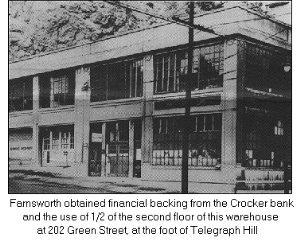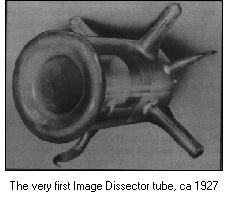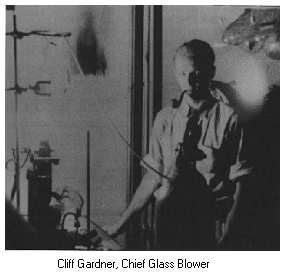"I don't think it is anything that would interest you in the least," George told Fagan. "It's not an investment, it's not even a speculation. It is wildcatting, and very wildcatting at that."
George's response served only to intrigue Mr. Fagan, who at the time was considered the most conservative banker on the West Coast. He was a wizened, tobacco-chewing veteran of the California Gold Rush. His steely judgment on investment matters had earned him the reputation as a "cold-hearted, glassy-eyed guardian of the money bags." Whatever the reasons for his interest, "Daddy" Fagan prevailed upon George to explain why he had come looking for McCargar.
With his crusty banker's sixth sense, Fagan listened as George described the genius he had stumbled onto. When George finished explaining Farnsworth's ideas, Fagan drummed his fingers together and spat a wad of tobacco at the solid gold cuspidor in the corner of the room: "Well, that's a damn fool idea, but somebody ought to put money into it," Fagan said, adding, "Someone who can afford to lose it."
Two days later, W.W. Crocker himself suggested in the strongest terms that George summon his young genius to San Francisco to meet Roy Bishop, a succesful capitalist and engineer of some standing.
When Farnsworth arrived, he looked every bit the part of the struggling inventor: frumpy, frayed, and preoccupied. So, George ouffitted Farnsworth in a new powder-blue suit, hat and haberdashery, and set out with his young protege to meet Roy Bishop for lunch.
Bishop listened intently as Farnsworth described how his idea would work. As the conversation wound down however, Bishop seemed to be somewhat reluctant. "I am convinced that the idea Is sound," he told Phil, "but I doubt your ability to work it out commercially."
Sensing Bishop's hesitation and the negative drift of the conversation, Farnsworth prepared to play his hand. For the moment he was holding all the cards. He knew what needed to be done to create television and he was confident that he could do it. But he could not afford to be involved with people who did not have equal confidence. Putting his papers in his briefcase and rising from his chair, Farnsworth courteously thanked Bishop for his kindness and time. As he turned toward the door he said, "I am sorry that you are unable to see the possibilities that I see for this invention." Stunned, George quickly gathered up his things and caught up with Phil at the door. As they were about to leave, Bishop said, "Wait a minute!"
The strategy had worked; Bishop demanded only one final stipulation. He wanted to consult with another "hardboiled" engineer, a man named Harlan Honn. "If you can convince him that your proposition is sound, then I think we can find a way of backing you."
Honn was summoned and arrived in less than half an hour. He looked over the specifications, asked some questions, and turned to George with a simple pronouncement: "Why sure this system will work. I think very well of it." Bishop reported all of his findings to the people at Crocker Bank, and the matter was held in abeyance until McCargar returned from vacation.
The meeting with McCargar and the other principals of Crocker Bank took place in the part of the inner sanctum that George sarcastically called "The Throne". While the bankers huddled in a far corner of the Directors Room talking the matter over, George and Phil sat on a marble bench at the foot of the "Throne" waiting to be called. Within a few minutes, McCargar came over and put his arm around George, saying "I think we are going to back you, boys." and ushered Phil and George into the oak and marble laden board room.
The circumstances of the meeting were unlikely at best, for this was a place where many requests were entertained but few were granted. What could this unproven, self-educated 1 9-year-old farm boy possibly say to these crusty robber barons that would compel them to cut loose enough cash to start something as far-fetched as television?
We can only imagine the atmosphere that must have prevailed that day, what cosmic forces had to converge on this room for this moment to happen; for happen it did: Philo T. Farnsworth swept in with another dazzling display of his unbridled genius and before the session ended he had been staked to the then-substantial sum of $25,000, and given the use of half of the second floor above a garage in San Francisco where he could set up a laboratory to implement his ideas.
Roy Bishop underscored the unusual nature of the event when he turned to Farnsworth with some admiration in his tone of voice and said, "Young man, you are the first person who has ever gotten anything out of this room without putting up something in return." Then Bishop addressed the rest of the group and delivered an ironic benediction: "We're backing nothing here but the ideas in this boy's mind. Believe me, we're going to treat him like a race horse." Phil was so excited about having a real chance to test his ideas that he accepted readily the terms that Bishop and Crocker had proposed. He knew little of the dealings of high finance, and he trusted that George would protect his interests. Phil was confident that everything would work out all right.
With all the papers signed, Phil returned quickly to L.A. in George's Chandler to pick up his bride and his little dining-room laboratory. Pem could tell the moment he stepped through the door that things had gone well in San Francisco. With his classy new suit he seemed to radiate success. Phil swept Pem off her feet and they danced around their little living room while he told her of the exciting things in store for them.
The pace of life quickened once again as Phil and Pem packed ail their belongings in the Chandler and drove up the coast, singing "Rose Colored Glasses" as they cruised through the cliffs of Big Sur.
Pem's brother, Cliff Gardner was folding cardboard into boxes on an assembly line in Oregon when a telegram from Phil and Pem arrived. The message mentioned cryptically that Phil had found financial support, but the remaining instructions for Cliff were a little fuzzy. Nevertheless, Cliff finished folding his last box and walked out to board a train for San Francisco.
Cliff waited everyday at noon for Phil and Pem to meet him near a corner specified in the telegram. He found a boarding house near the designated intersection and waited expectantly for five days before Phil and Pem found him, hungry, nearly broke and happy as hell to see them.
 Together the reunited trio went off to find 202 Green Street, the empty loft that the bankers had provided for Farnsworth's new laboratory. Phil knew the moment he set foot in the place that he had arrived at the birthplace of television.
Together the reunited trio went off to find 202 Green Street, the empty loft that the bankers had provided for Farnsworth's new laboratory. Phil knew the moment he set foot in the place that he had arrived at the birthplace of television.
Later that night, with the Dempsey-Tunney long count fight playing in the background, Phil and Pem took the ferry to Berkeley fo find a home. They were lucky and on the first day discovered a perfect apartment. Pem started to set up housekeeping while Phil began setting up his laboratory.
Cliff Gardner was officially installed as chief glass blower. His training for the job included a high school diploma, boldness comparable to Phil's--and absolutely no previous knowledge of the subject.
When Farnsworth had finalized the plans for his television system and drawn detailed diagrams, he filed for his first patent. The application was submitted on January 7th, 1927, and to the extent that these documents disclosed an invention that would work, that date is the official date that television was invented.
Still, the patents could not be officially granted until the device had been proven to work, or "reduced to practice." And that was still a long way off.
 After a few months, Cliff had mastered the fundamentals of his new craft and he began building the world's first electronic television camera tube. Farnsworth called this device the "Image Dissector" because it would transmit an image by dissecting it into individual elements and convert the elements --one line at a time-- into a pulsating electrical current.
After a few months, Cliff had mastered the fundamentals of his new craft and he began building the world's first electronic television camera tube. Farnsworth called this device the "Image Dissector" because it would transmit an image by dissecting it into individual elements and convert the elements --one line at a time-- into a pulsating electrical current.
A very rare substance called cesium was chosen for the photo-electric surfaces that would perform this miracle. The only way they would acquire sufficient cesium was by purchasing cases of radio tubes which used small cesium pellets to absorb any gasses that remained after all the air had been pumped out of the tubes. Consequently, all the tubes had to be smashed in order to retrieve the pellets.
On For the receiving end of his system, Phil used a standard Erlenmeyer flask, like the flat-bottomed ones he had used in his high school chemistry class, for the first "picture tube," which he dubbed the "Image Oscillite."
 Phil and Cliff spent a year laying the foundation for television. Late in summer, 1927 they rigged together a rudimentary apparatus and began testing it to see if the system could send an image from the camera to the receiver. The first few tests revealed very little. The receiver glowed when the current flowed through the cathode ray tube, but Phil couldn't see anything except electronic interference on the screen. Ignoring his discouragement, he analyzed the results from each test and redesigned parts of the system.
Phil and Cliff spent a year laying the foundation for television. Late in summer, 1927 they rigged together a rudimentary apparatus and began testing it to see if the system could send an image from the camera to the receiver. The first few tests revealed very little. The receiver glowed when the current flowed through the cathode ray tube, but Phil couldn't see anything except electronic interference on the screen. Ignoring his discouragement, he analyzed the results from each test and redesigned parts of the system.
On September 7, 1927 the system was ready to be tested again. This time Phil was so confident that he invited George and Pem to the lab to see his first "transmission".
For his test that day, Phil chose the simplest of images. He painted a thick straight line onto a glass slide. While this seems like a rather arcane choice of subject for such an important occasion, it was in fact exactly what Farnsworth needed: if he could tell by looking at the receiver whether the line was vertical or horizontal, then he could be certain that he was looking at a transmitted image.
In one room, Cliff Gardner dropped the glass slide between the Image Dissector and a hot, bright, carbon arc lamp, and the Information Age was born: In the other room Phil, Pem and George watched the face of the receiver as it flickered and bounced for a moment. When the system settled down, all present could see the straight-line image shimmering boldly in an eerie electronic hue on the bottom of Farnsworth's magic tubes. When Cliff rotated the slide, everybody could see the image on the receiver rotate as well, clearly proving that they were witnessing visual intelligence being transmitted from one place to another.
Later that evening, Philo T. Farnsworth recorded the arrival of true video with a simple scientific statement in his laboratory journal when he wrote, "The received line picture was evident this time."
But in a telegram to Les Gorrell in Los Angeles, George Everson put it much more succinctly: "The damned thing works!"

 1977, 1995 Paul Schatzkin; All Rights Reserved
1977, 1995 Paul Schatzkin; All Rights Reserved